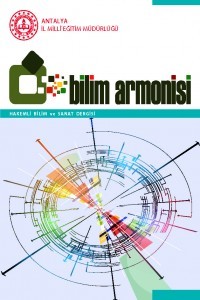Vektörden Küreye
Küre, üç boyutlu bir cisim olup, uzayda sabit bir noktadan eşit uzaklıktaki noktaların oluşturduğu bir cisimdir. Küre merkezinden üç boyutta (x,y,z) eşit uzaklıktaki (yarıçap r) yayılmış her bir nokta kürenin yüzeyinde yer almaktadır. Başka bir deyişle orijin noktasından x ve y koordinatlarından eşit uzaklıkta çizilen bir yayın z ekseni etrafında 360 derece döndürülmesi ile küre şekli elde edilir. Uzayda verilen 3 nokta A(a,b,c), B(p,r,s) ve P(x,y,z) noktaları olsun. Bu noktaların belli şartlarda birleştirilmesinden bir küre oluşturulur mu ve oluşturulan bu kürenin merkezi hacmi ve yüzey alanı ile ilgili bilgiler elde edilebilir mi? Vektörler ve küre arasında bir ilişki kurulabilir mi? sorularına çözüm bulmak için yapılan araştırma ve literatür taramalarında bu şekilde bir ilişkinin ispatı ve genel bir kural olmadığı gözlenerek bulunan boşluk yapılan işlemlerle ispatlanarak doldurulmaya çalışılmıştır. Bu çalışma ile elde edilen genel kurallar uzayda kurulan bir küre için genel küre denklemi ile bu küre arasında yarıçapa bağlı kalmadan yüzey alan hacim ve küre merkezi bulunması için sonuçlar vermiştir. Burada verilen noktalara bağlı k sabiti için elde edilir. Verilen kürenin dışındaki bir A(a,b,c) noktası, kürenin dışından alınan bir B(p,r,s) noktası ve küre yüzeyinde olduğu bilinen bir P(x,y,z) noktası için merkezi M(X,Y,Z) olan bir kürenin bu noktaları bulunur. Aynı zamanda kürenin yüzey alanı ve hacmi ifade edilir. Burada istediğimiz öncülleri sağlayan uzayda alınan üç nokta için genel küre formülleri elde edilmiştir.
Vektor to Sphere
A sphere is a three-dimensional object made up of points equidistant from a fixed point in space. Each point spread equidistant (radius r) in three dimensions (x,y,z) from the center of the sphere is located on the surface of the sphere. In other words, a sphere shape is obtained by rotating an arc drawn at an equal distance from the origin point in x and y coordinates by 360 degrees around the z axis. Let the three points given in space be A(a,b,c), B(p,r,s) and P(x,y,z). Can a sphere be formed by connecting these points under certain conditions, and can information about the central volume and surface area of this sphere be obtained? Can a relationship be established between vectors and spheres? In the research and literature reviews carried out to find solutions to these questions, it was observed that there was no proof of such a relationship and there was no general rule, and the gap was tried to be filled by proving it with the procedures performed. The general rules obtained from this study gave results for finding the general sphere equation and the surface area, volume and sphere center of a sphere established in space, without depending on the radius. It is obtained for the constant k depending on the points given here. For a point A(a,b,c) outside the given sphere, a point B(p,r,s) taken from outside the sphere, and a point P(x,y,z) known to be on the surface of the sphere, the center M(X,Y, A sphere with Z) has these points. At the same time, the surface area and volume of the sphere are expressed. Here, general sphere formulas have been obtained for three points in space that provide the premises we want.
___
- Ay, M. (2013). “Küre Yüzeyi Üzerinde Apollonius Eğrileri”. Yüksek Lisans Tezi, Celal Bayar Üniversitesi. Aydın-Türkiye.
- Ayres, F. (1954). Schaum’s Outline Of Theory And Problems Of Plane And Spherical Trigonometry; Mcgraw-Hill New York-ABD.
- Bell, A. (2006). “Hansen’s Right Triangle Theorem: Its Converse And A Generalization”, Forum Geometricorum, 6: 335-342.
- Brannan, D., Esplen, F. ve Gray, J. (1999). Geometry: Cambridge University Press. Cambridge-Birleşik Krallık.
- Brannan, D., Esplen, F. ve Gray, J. (2011). Geometry: Cambridge University Press. Cambridge-Birleşik Krallık.
- Hansen, D. W. (2003). “On İnscribed And Escribed Circles Of Right Triangles, Circum Scribed Triangles And TheFour-Square, Three-Square Problem”. The Mathematics Teacher, 96 (5): 358-364. doi: Https://Doi.Org/10.5951/Mt.96.5.0358.
- Haruki, H.,Rassias, T. M. (1996). “A New Characteristic Of Möbiustrans for mations by use Of Apollonius Points Of Triangles”. Journal Of Mathematical Analysis And Applications, 197: 14-22.
- Karataş, H. G. (2016). “Dik Üçgenler İle Pythagorean Üçgenleri İçindeki Pythagorean Üçgenlerinin Bazı Özellikleri ve Öğretimi Üzerine Bir Araştırma”. Yüksek Lisans Tezi, Necmettin Erbakan Üniversitesi. Konya-Türkiye.
- Kirişçi, S. Ö. (2017). “Bazı Çokgenlerin Apollonius Noktaları Yardımıyla Möbius Dönüşümlerinin Karakterizasyonları”. Yüksek Lisans Tezi, Aydın Kocatepe Üniversitesi. Aydın-Türkiye.
- Kramer, A.V., Luca, F. (2000) “Some Remarks on Heron Triangles.”Acta Academiae Paedagogicae Agriensis, SectioMathematicae, 27, 25–38,ISSN 1787-6117.
- Şahin, R. (1997). Geometri 1 – 2: Sürat Yayınları. İstanbul-Türkiye.
- Van De Walle, J. A. (2001). Elementary And Middle School Mathematics. Teaching Developmentally: Longman. New York-ABD.
- Zelator, K. (2008). “Certain Properties Of Pythagorean Triangles Involving TheInterior Diameter 2ρ , And The Exterior
- Diameters 2ρα, 2ρβ, 2ργ; Part II: TheLegs Case”doi: https://doi.org/10.48550/arXiv.0803.3605
- ISSN: 2602-4403
- Yayın Aralığı: Yılda 2 Sayı
- Başlangıç: 2018
- Yayıncı: Antalya İl Milli Eğitim Müdürlüğü
Sayıdaki Diğer Makaleler
Hasan ŞAHİN, Uygar Yağız KENDİRCİ
Şehrimizin Yaşayan Değerinin Medyaya Yansımaları: Ahilik
Seray ALTUNÖZ, Gürkan Kağan ÖZBEK
Yaygın Eğitime Yönelik Sosyal Kabul
Merve Hilal DEMİRKAN, Zeynep MOSCHİNİ
UV Radyasyonuna Karşı Antioksidan İçerikli Diyetlerin Fotokoruyucu Etkilerinin İncelenmesi
